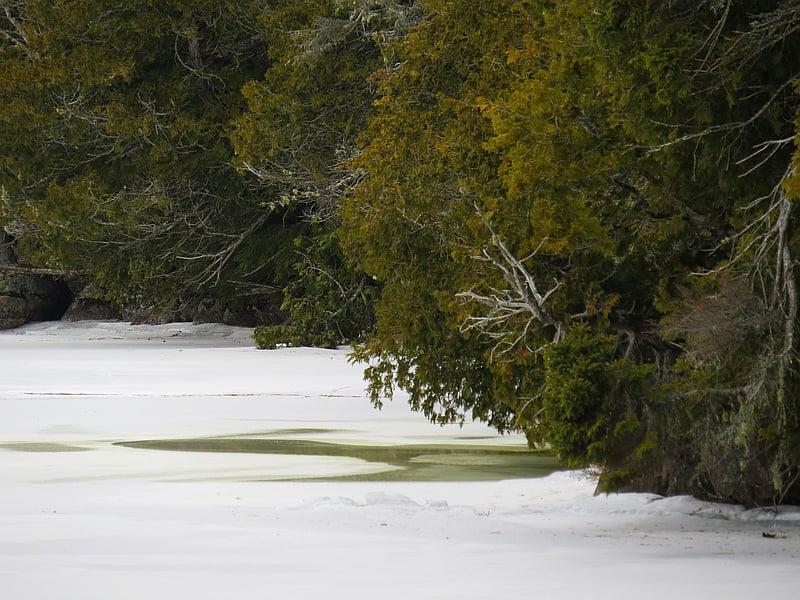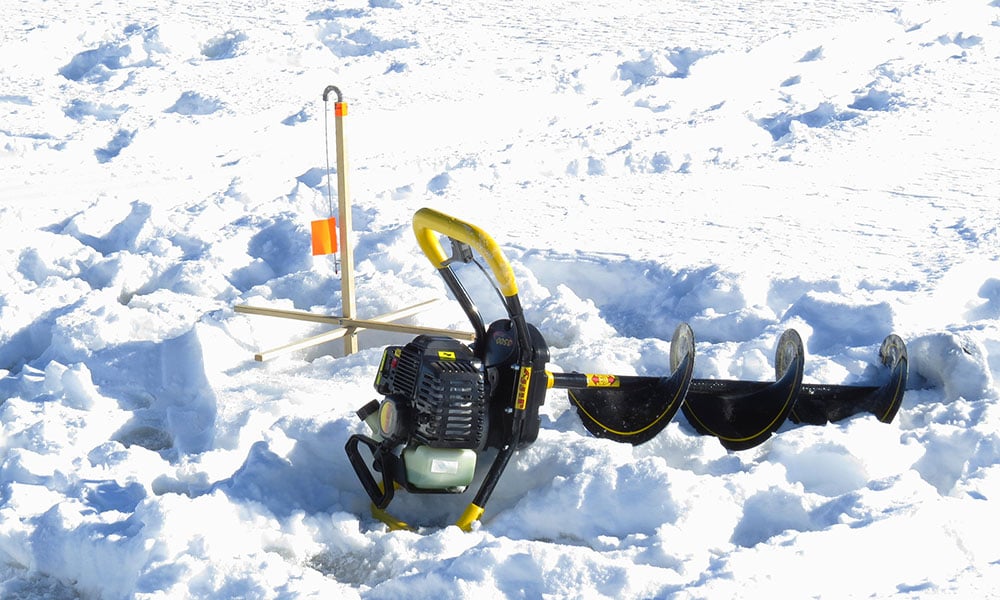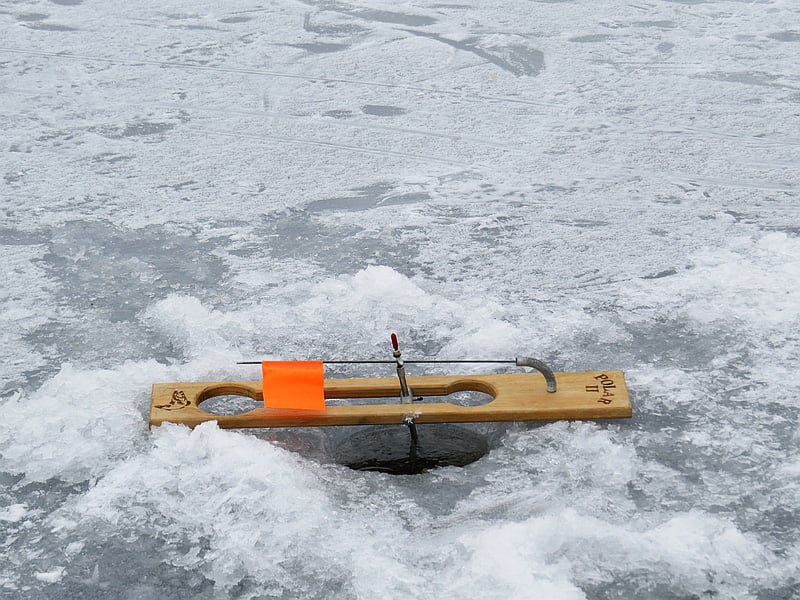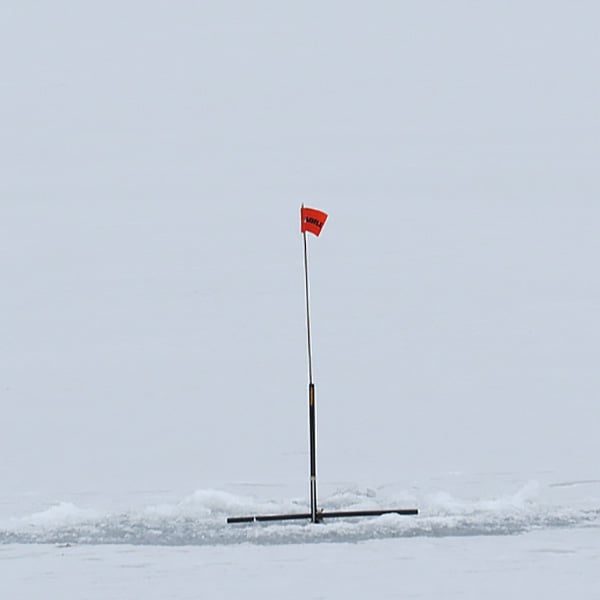Last Updated on
Ice fishing – one of winter’s best activities and a long-standing tradition that keeps outdoors folks busy during long winters. We watch the forecast for “good ice making weather” and hope January thaw doesn’t set the ice making too far back. We wait for the first reports of four inch thick ice from the locals who know the lakes and ponds well.
Safety
For safety sake, don’t rush onto the ice. Walk carefully, single file, one step at a time, and have someone on shore with a rope who is ready and capable of helping you if you break through. Safety spikes have helped a lot of people stay above the ice when they broke through. Two spikes, each with handles to give you a firm grip, are attached with cord. The cord crosses the back of your neck and the spikes hang in front of you. If you break through the ice you “grab and jab” the spikes into the ice and use them to hold yourself up. A life jacket on shore can be tied to a rope and thrown to someone who’s fallen through. Your rope should be at least 25 feet long to help you avoid getting close to the weakened ice.

Protect your skin. Sun reflects from the snow and ice, and even on the coldest days you can get a sun burn. Use sunscreen from brands like Simms and wear sun glasses. Sunscreen will help protect your skin from the wind, too. A wind burn can be just as red, dry and painful as sunburn.
Counter the ice’s slip with cleats. They attach to the bottom of your boots and create traction with spikes or coils.
Check ice thickness as you go. Snow is an insulator that can slow down freezing. Moving water, vegetation under the ice and springs can slow freezing and create unexpected weak spots.
- 4” It’s probably safe to walk single file on ice that is 4” thick. Space yourselves out a few feet.
- 6” is considered safe for an ATV or snowmobile
- 8-12” is considered safe for a small truck
- 12-15” is safe for a medium truck.
- 15” and up is considered safe for full sized trucks. Every year vehicles are towed off broken ice or worse, from the bottom of lakes.
Be careful of ice rot later in the season. Porous, shifting ice quickly becomes unsafe as it’s melting.
Laws
Laws vary from state to state, county to county, and water to water. What’s legal on the body of water you want to fish? The bait you’re allowed to use, size and number of fish you may keep, how you bait, how many traps you may have and more is important to know.
I can keep one smallmouth bass on my favorite pond. It’s a dilemma. Do I keep the 18” smallie knowing there are larger fish in there or throw it back and take my chances? The weather always plays a roll in my decision. If it’s bitterly cold I’m keeping the first 18 inches. If it’s a slow day I’ll probably keep the first nice fish. If the action is heavy or the weather is great I will take my chances. Bigger fish equal better bragging rights and more meat on my supper plate.
When catching a species with an unlimited or high limit we keep all decent sized fish and return the small ones to the water quickly. Don’t keep your catch out of the water any longer than necessary. Freezing temperatures causes damage quickly, especially to eyes and gills. Quick decisions matter.
Know the species so you don’t keep a fish you shouldn’t. If your state offers a species identification card you should have one or two for yourself and more to share. They’re great for new anglers, especially children who love to collect swag.
It’s helpful to keep the law book in your fishing gear. When in doubt, look it up right there on the ice.
Gear
The list of gear you need isn’t long. It doesn’t get long until you get into the wants, and there are a lot of wants. When we set up for a day of ice fishing we look like a display in outdoor sports store If we’re out for only a few hours we catch just as many fish with a lot less gear.
You need a way to make a whole in the ice, usually an auger. Augers are hand, gas and propane powered. Hand augers are smaller and light weight making them slower to use but easier to transport, especially if you have to walk to your destination. Gas and propane augers are larger, heavier duty, make quick work of drilling holes, and usually do break down to make moving them easier. They are loud, with gas being loudest, and have hot exhaust you have to be careful of. If you’re drilling a lot of holes in a day, this is the way to go.

The wider the hole the harder the work. If you are fishing for walleye, whitefish, small to mid-sized trout, crappie and similarly sized fish you’ll be fine with a five to six inch hole. If you’re looking for large trout, large and smallmouth bass, pike and other large species you’ll want a larger hole, probably eight inches. A ten inch hole is nice to look into and you’ll be able to see the fish easier but they are more difficult to drill even with a gas or propane powered auger. If you don’t have an auger you can use a chisel, an ax or a chainsaw if the ice isn’t too thick.
Traps, also known as tip ups, offer a lot of choices in size and cost. If you’re starting to build your gear you’ll probably want to buy as many traps as you’re allowed holes. If you can afford heavy duty traps by all means, make the investment and be done with it. Otherwise, buy one or two heavy duty traps and fill in with less expenses pieces. Later, replace with heavy duty as the others wear out.
Traps that lay flat are good when there’s little or no snow on the ice or you’ll be placing them close to you. If you’re spreading your traps out you’ll want taller traps. A bright orange or black flag is easier to spot against the ice and snow when your traps are farther away. Traps are typically made of plastic or wood.

Thermal traps cover the hole and slow down refreezing. They’re particularly helpful in shallow water because they keep bright sunlight out of the hole and away from the fish.
You’ll need a scoop to clear ice chips from the hole. Make sure the scoop isn’t too big for the holes. Double duty – look for a scoop with a ruler on the handle. You can measure the thickness of the ice and your fish.
Use line made for ice fishing on your reels. There is a difference. This line is coated to repel water, resist ice buildup, and reduce freezing. It’s more likely to slide across sharp shards of ice. It stays flexible and sensitive in the icy cold water. Traditional filament will leave you frustrated.
A sounder is used to bring the hook to bring the hook to the bottom of the lake. From there you decide how far off the bottom or close to the top you want to fish. Check the material in sounders. Some states have outlawed lead. Other states allow lead as long as it has been sealed with paint.
You’ll need a sinker if you’re using live bait to keep it from swimming away. Place the sinker 12” to 18” above the hook to allow room for the fish to move. We use the same hooks for ice and open water fishing.
If you’re using live bait you’ll need a bait bucket. Choose an insulated bucket to keep the water from freezing. A small net makes catching the bait fish easier and your hands drier and warmer.

Shelter
A shelter can make a blustery day on the ice comfortable. An ice fishing shelter can be as elaborate or simple as you like. It can be portable and go with you from lake to lake or set up on the lake for the length of the season. Often called shacks, these “shacks” might be insulted, have heat, a stove and bunks so you can spend the night. We don’t take our portable shelter with us on a nice day or if we’ll be out just a few hours but most of the time it’s with us, set up and well used.
Utility Sled
A heavy duty utility sled will carry your gear to the ice in a trip or two. On the ice, you’ll be able to keep your traps, bait, scoop and fish together.
Tips
A busy day chasing flags is a lot of fun. But what do you do when the fish aren’t biting? You sit still and get cold. You’ll probably pull up your traps and go home sooner on a slow day.
- Look at maps, depth charts or Google Earth before you leave home. Find inlets and outlets to help you avoid thin ice, and look for ridges and drop offs to find good places to fish.
- If you get cold get up and walk. You’ll warm up.
- Check your bait. You might have had a bite that stole your bait but didn’t trip the flag. Replace dead bait fish, and save them if you’re going to fish for cusk or other species that prefer dead bait.
- If the fish aren’t biting change your bait. Change the color, style or depth.
- If changing your bait doesn’t work try changing location.
- While checking bait, scoop the ice out of the hole.
- Use hand warmers. I put them in my wool mittens on the coldest days and in my coat pocket on warmer days.
- A button on the line marks the depth you want to use. Place the button on the line before the leader. Move the button according to the depth and reel in the line until the button touches the reel.
- Catching too many small fish? Use bigger bait.
- Bring your traps inside to dry out when you get home. The line won’t freeze to the reel if it’s dry.
If you forget to bring the traps in you can soak the reel in the lake for a minute or two.












2 comments
I’ve never tried ice fishing but now I really want to! Great article!
Nice job ! Robin. I’m ready for some Ice fishing..